Nuclear Safety and Industrial Video Surveillance
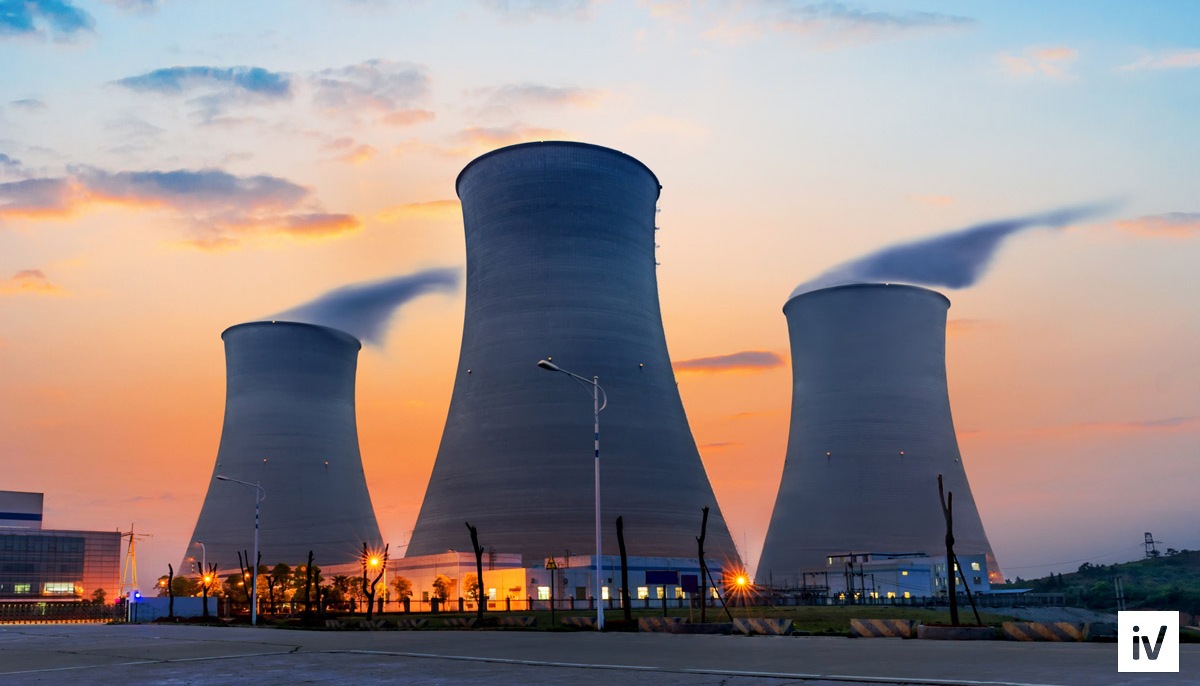
We see a request for video analytics in retail, in the HoReCa segment, in the banking sector - we need to count visitors, identify new and VIP clients, and maintain a “black list”. These requests have nothing to do with the nuclear industry, and one of the first customers of the Ivideon face recognition system was OKAN, a manufacturer of equipment for nuclear power plants. Today, “OKAN” with the help of video analytics increases safety in the workplace.
Nuclear energy is a conservative industry, but this does not mean that there is no place for new technologies in it. Our experience testifies: high technologies are in demand in production, but this is not about new products circulated in the media. Nuclear and hydroelectric power stations, oil and gas pipelines, factories, as well as many other systems vital to humanity, are extremely sensitive to manufacturing errors. Here, security systems - in particular, video surveillance - have special requirements.
Small business in the nuclear industry
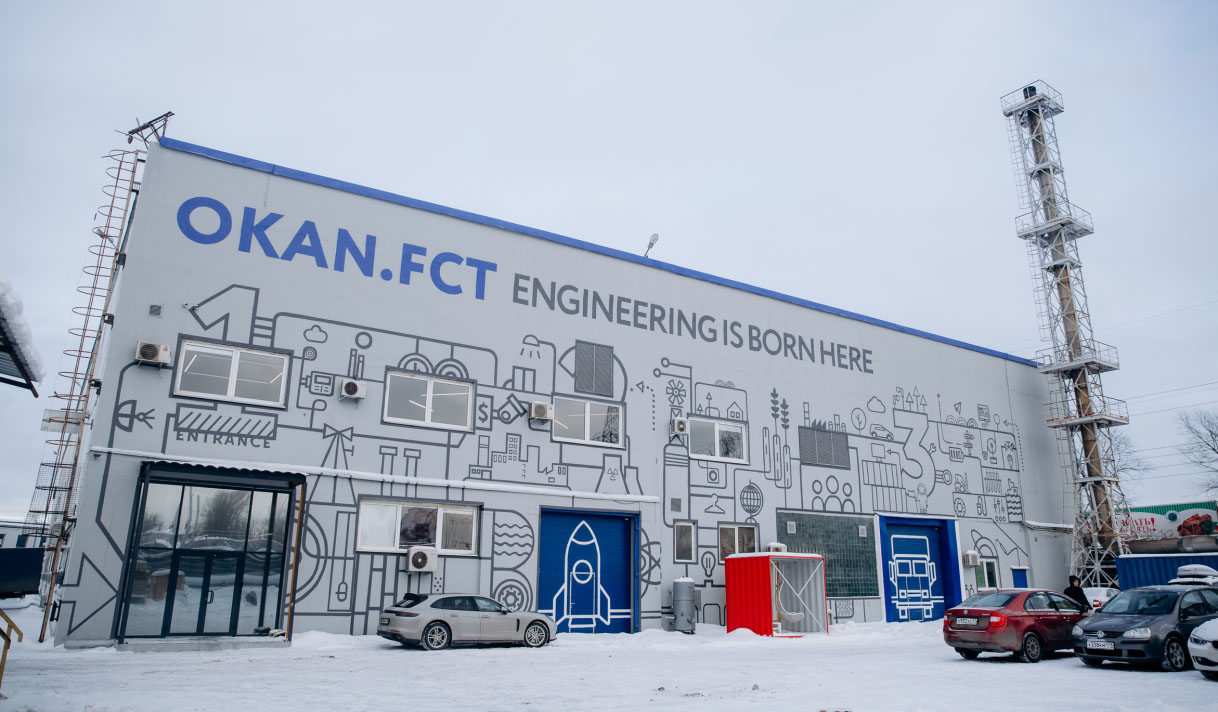
OKAN (the combined company "Fittings and Pumps") is engaged in projects that do not have a serial technical solution: control, shut-off, protective valves. OKAN solves a wide range of engineering problems: from determining initial technical requirements to developing operational and repair documentation. The company put on stream the production of thermomechanical equipment at foreign and Russian factories (the share of its own production is 30%).

One of the youngest startups in the Russian nuclear industry in six years of life has developed and supplied pipeline fittings for the Byelorussian, Beloyarsk, Novovoronezh (NPP-2), Leningrad (NPP-2), Taiwan and Kudankulam nuclear plants, as well as the vessel’s floating power unit Academician Lomonosov ”and the nuclear icebreaker“ Arctic ”.
The focus of production is steam generators, steam valves, regulators and valves that provide normal pressure and the required water level to generate a nominal steam flow rate. This area of work is not often remembered in discussions about the safety of nuclear power plants, although defects in water cooling elements and steam generation systems have already led to several serious nuclear accidents.
NPP: the problem of delayed action
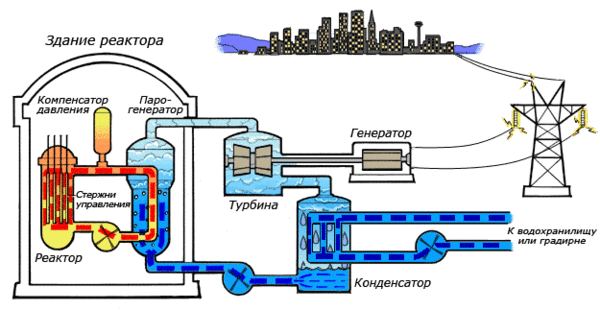
Illustration of the operating principle of a dual-circuit nuclear power plant
The heat released during the chain reaction heats the primary coolant - water, which is supplied from below to the reactor core using circulation pumps. Water passes through thousands of heat exchanger tubes of the steam generator and, having given part of the heat to the second office, enters the core again. Since the pressure of the secondary circuit is lower, the water in the steam generator boils, forming steam. Entering the high-pressure cylinder, and then the low-pressure cylinders, steam spins a turbine, which, in turn, rotates the generator, generating electricity.

Robert Emmett Genie Nuclear Power Plant
High pressure, nodal and moving elements of the system, repeatedly increase the risk of damage. One of the most noticeable accidents of the steam generator occurred on January 25, 1982. A steam generator tube exploded in a genie with a 515 MW water-cooled nuclear reactor : radioactive steam consisting of krypton and xenon burst into the atmosphere.
During the post-emergency inspection, a small metal plate was found inside the steam generator, which, apparently, was left through negligence during maintenance several years before the incident. Due to the constant vibration of the object in the water stream, the generator tubes suffered serious damage, and in one there was a longitudinal rupture, through which 53 tons of water from the first circuit flowed into the second.
The problem of the integrity of heat transfer tubes at foreign nuclear power plants has been solved without much success since the inception of the “peaceful atom” industry. For Russia, this task is also relevant. Although the two-circuit scheme used in our work is safer than, for example, the single-circuit at Fukushima nuclear power plants - radioactive media are inside the containment, and there is no steam in the primary circuit that increases the risk of fuel overheating - problems with steam generators are widespread.

The nuclear power plant near the city of Balakovo is one of the most modern in the world and the largest in capacity (4,000 MW) in Russia.
Blocks of the Balakovo NPP several times stopped for unscheduled repairs due to poor-quality design, manufacture or operation of steam generator elements in which defects arose and developed. The appearance of through cracks in the heat exchanger tubes leads to the leakage of water from the first circuit into the second and, ultimately, the unit stops for repair.
After the breakdown of the heat exchange tubes at the Novovoronezh NPP in 2003, the downtime lasted five months. Two years later, at the same nuclear power plant after an emergency operation of the protection , the turbogenerator of the fourth power unit was disconnected from the network. At the same time, defects in the pipeline led to the shutdown of the second power unit at the South Ukrainian Nuclear Power Plant. On the morning of January 10, 2010, due to an accident at the steam generator, the first power unit of the Volgodonsk NPP was stopped and put into unscheduled repair.
Although the radiation safety of the plant for nuclear scientists is always considered the highest priority, exceeding the factor of electricity production and meeting the work schedule, intentions alone are not enough to prevent incidents and accidents. The professionalism of staff is more than offset by errors at the production stage.
Atomic projects

The photo above shows OKAN valves, which have become part of the complex security system of the first power unit of the Leningrad NPP-2 with water-cooled power reactors.
Valves are installed in the piping system to provide all starting and stopping modes of steam generators. At LNPP-2, several channels of safety systems overlapping each other were used: a melt localization device, passive heat removal systems from under the reactor shell and from steam generators.

On March 9, 2018, power unit No. 1 of the Leningrad NPP-2 issued the first kilowatt-hours of electric energy to the country's unified energy system
None of the operating nuclear power plants in the world is equipped with such a configuration of safety systems. The closest analogue is, contrary to the name, in China - at the Tianwan NPP. The Tianwan Nuclear Power Plant is based on the Russian project: at the station, similarly to Leningrad NPP-2, water is used as a coolant and neutron moderator. OKAN participated in the Russian-Chinese nuclear project as a subcontractor.
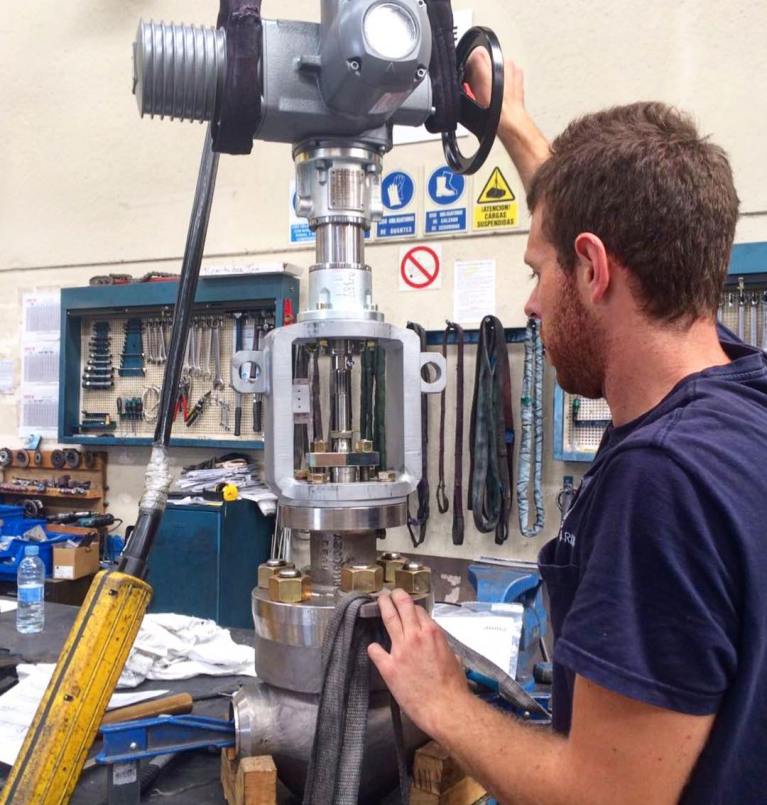
Valves for Tianwan NPP
OKAN supplies safety and control valves designed for installation on steam pipelines for supplying fresh steam from the steam generator to the turbine, low pressure valves and high pressure valves with pneumatic actuator, and other elements intended for operation in the steam piping system and passive heat removal system through steam generators.
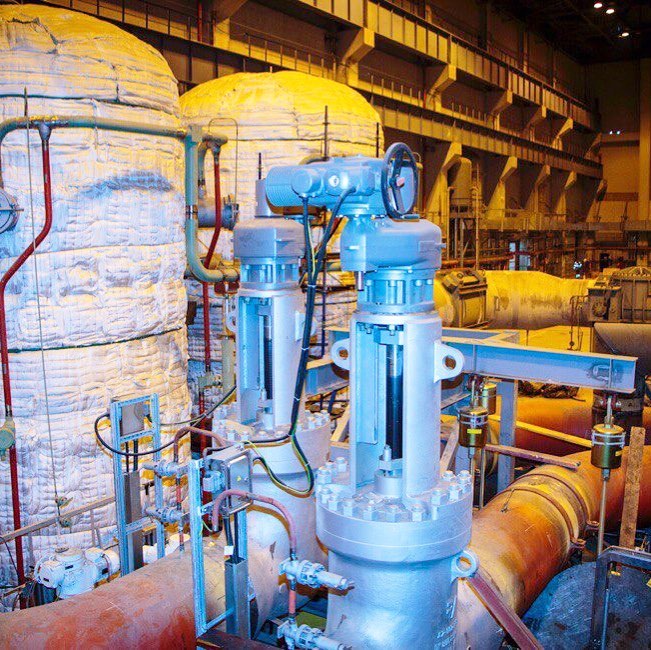
In the photo above - the shut-off valves of the LNPP-2 installed after the quick-acting shut-off and shut-off valve (BZOK) on the steam line connecting the steam generator and the turbine. Gate valves are designed to cut off the turbine from the steam generator. All this is part of a large nuclear power plant protection system in an emergency.
In normal operation, steam flows from the steam generator into the turbine through the BZOK. In an emergency, as a result of a steam line rupture or overpressure, the BZOK shutter closes (cuts off) and steam is not supplied to the turbine, but to the valve of the high-speed reduction unit and valves of the pulse-safety devices - then the vapor (non-radioactive) is discharged into the atmosphere.
Standards, quality and video surveillance
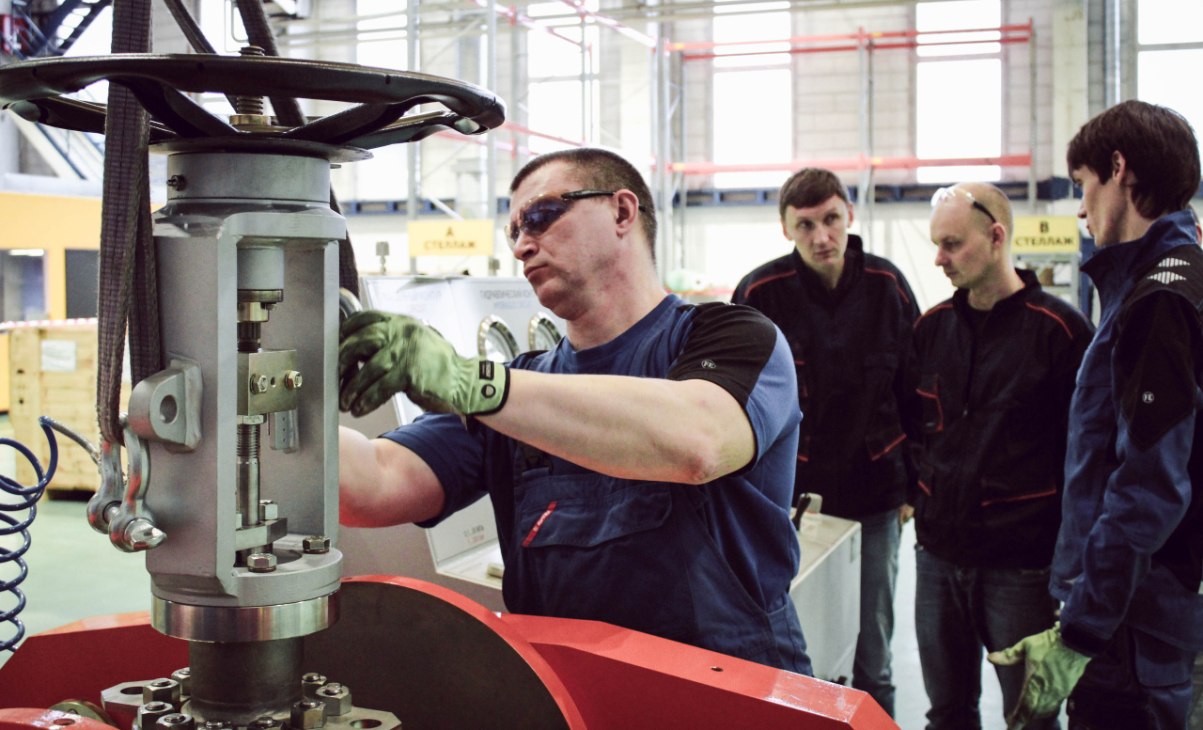
Scheduled maintenance of pipe fittings
Solving problems after the fact is usually costly and inefficient. Raising product quality to such a level that there are no leaks in the steam generators at all or are at the lowest acceptable level, as well as increasing the life of the steam generators and lowering the cost of maintenance, is closely monitored.
One of the stages of development on the Western market is the radiographic inspection of castings in accordance with the standards of the American Society of Mechanical Engineers (ASME). Updating ASME standards, including for boilers and pressure vessels, occurs every three years and is a significant event in the standardization industry.
All parts for nuclear power plants undergo visual and measuring control - including roughness measurement with a profilometer, control of the “saddle - spool” contact surface of the shutter valve, assembly and testing on a hydraulic bench. Only valves at different stages of production pass more than a dozen forms of control in accordance with Russian and international standards.
Video surveillance is a significant part of production quality control. OKAN uses Ivideon to monitor people in the danger zone when creating and testing parts.

The Ivideon cloud face recognition system does not require the purchase and setup of additional cameras, and works with the equipment that is already installed at the observation point. Access is provided from any computer. It is enough to know the password.
No need to keep a staff of specialists for equipment maintenance - technical problems are solved on the cloud side. The basic settings are made in the interface of the user’s account of the service and can be changed independently.
Ivideon Faces is transforming a bulky and vulnerable system from on-premises analytic servers to a flexible cloud. In practice, this means that the recognition module is practically independent of the capabilities of the IT infrastructure in the office or in the workplace.

Danil Dekan, senior system administrator, OKAN
“Safety is paramount in the workplace. Perimeter protection, notification of employees about intrusions and suspicious behavior, including safety violations, are a mandatory part of the video surveillance system.
Persons who are not employees may enter the production line - in this case a notification will come. In addition, even among the employees themselves, some are allowed to enter certain areas of the facility, while others are not.
Cameras will help with incident investigation. With them it’s easier to determine who is responsible for the incident and organize further work without errors. ”
All Articles